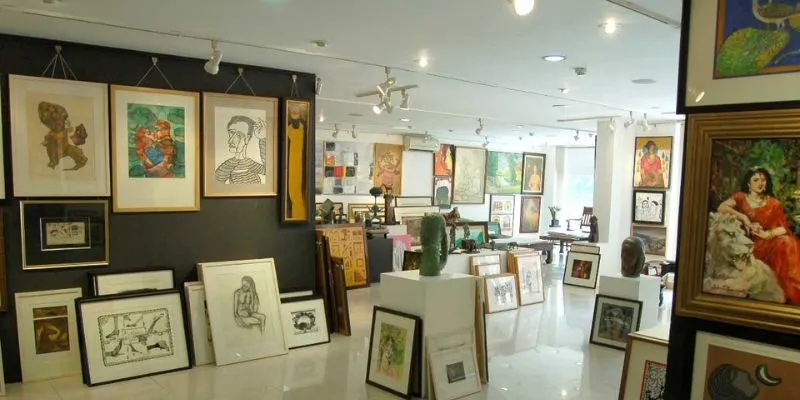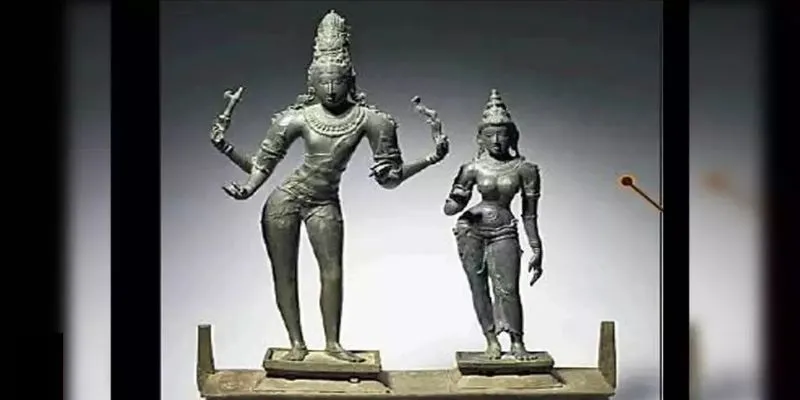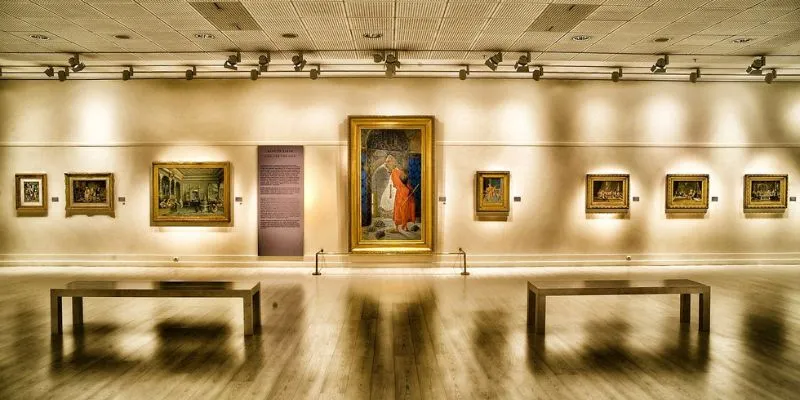If you are an art lover, mark a date in your calendar to visit the National Art Gallery Chennai. The gallery is located on Pantheon Road, Egmore. It also encloses the Government Museum and the Connemara Library. Built in the year 1906, it houses one of India’s priced possessions, like Tanjavur & Rajasthani paintings and soulful sculptures. Another notable attraction is that the gallery is built with red stones, brought from Satyavedu, Andhra Pradesh.
Paintings – A visual Treat
Raja Ravi Varma painted a number of Mughal-era paintings that are on display at the museum. From Afghanistan in the northwest and Kashmir in the north to the highlands of modern-day Bangladesh and Assam in the east, the Mughal Empire covered a vast area. Akbar, Jahangir, and Shah Jahan were the three great emperors that ruled during the illustrious age of Mughal art. In the macho atmosphere of the royal workshops, Hindu and Muslim artisans and painters from the northern parts of the Indian subcontinent collaborated with Iranian masters. Their vastly dissimilar artistic backgrounds were blended to create a completely original and quickly developing style of art for the court.
Archaeological and Numismatic Collections
The Chennai Art Museum has good collections of traditional and contemporary paintings and sculptures, including modern paintings in acrylic, watercolour, oil, and graphic materials and traditional paintings of the Tanjore, Rajput, Moghul, Kangra, and Deccani schools.
The museum has a long history. A large portion of the structures and the surrounding land had to be given up between 1941 and 1946, or during both the Indian freedom movement and the official World War II, to make way for an ARP depot in the museum. The showcases had to go because the galleries needed to be converted into storage spaces. The most priceless items in the collections—bronzes, copper plate grants, particular coins, Bhattiprolu relic caskets, etc.—were transported to secure locations. Because the sculptures from Amaravati were too heavy and challenging to transport, they were told to be protected in a gallery. You can still find these wonders in the museum.
World-famous Chola and other south Indian bronzes, Amaravati sculptures, armoury weapons from the Thanjavur kingdoms, stone inscriptions, copper plate grants, Dowleshwaram gold coins of Raja Raja I and Kulothunga I, Chengam copper coins, prehistoric Adhichanallur artefacts, Bruce Foote’s collection of prehistoric stone implements, Roman artefacts from Arikamedu (near Pondicherry), exquisite crystal reliquaries from Bhattiprolu stupa, and the massive whale skeleton found on the coast close to Mangalore are among the museum’s notable holdings.
Bronze Sculptures
The Bronze gallery in the art gallery in Chennai has a marvelous collection of South Indian bronze sculptures from the Pallava and Chola era (7th to 11th centuries) to the most modern times. These classic bronze sculptures are mostly made of “Panchaloha,” an alloy of key five metals, including gold, silver, and copper.
The Bronze Gallery sculpture collections include Hindu-Savivite and Vaishnavite, Jain, and Buddhist sculptures. The Pallava sculptures exhibit plain, simple, realistic anatomy, oval faces with large eyes, less ornamentation, and cylindrical headgear. The medieval Chola sculptures show rigid and artistic anatomy, slightly rounded faces and more ornamentation with detailed patterns. While the Vijayanagara sculptures followed the Chola style of sculpting and gave more attention to sculpture details.
Some of the Saivite bronze sculptures displayed in the gallery include idols of Ganesa, Brahma, Sukhasana, Umasahita, Somaskanda, Gangadhara, Natesa, Kalyanasundara, Chandrasekhara, Pradosamurti, Nataraja, Chandikesvara, Umasahita, Vinadharadakshinamurti, Tripurantaka, Virabhadra, Bhairava, Nandi, Subrahmanyadevi, and many other noteworthy artefacts. You can also witness sculptures of gods and goddesses like those of Subrahmanya, Valli, Sivakami, Parvati, Sivagami, Devi, Ganesa, Sivakamisundari, Kali, Bhadrakali, Aiyyanar on elephant, and saints like Tirugnanasambandar, Kannappanayanar, Appar, Thirujnansambandhar, and Manickkavachakar. Your visit to bronze sculptures is not complete without visiting the statues of Ayyanaronelephant, Mahishasuramardini, Mahesvari, Ardhanarisvara and Adhikaranandhi.
Why should we visit the National Art Museum, Chennai?
The significance of art museums throughout history cannot be overstated. They have not only served as repositories of cultural heritage and cherished stories but have also been influenced by political agendas. Particularly, When you visit the National art museum, you are not only exposed to the creativity of different cultures and historical narratives, but you also find an opportunity to reduce stress and immerse yourself in the present moment.
The Egmore Museum has the power to evoke positive emotions and stimulate intellectual curiosity. It is not just a repository of artefacts; it serves as a community center, inspiring change and development. Furthermore, studies have shown that visiting museums can result in positive mindset changes, fostering increased empathy and reflection on social issues.
The institution of museums has evolved over the years to encompass diverse aspects of human society, science, art, and history. They play a vital role in preserving the past, understanding the natural world, and exploring the complexities of cultural interactions. Overall, the government museum in Chennai offers valuable spaces for learning, personal growth, and spending quality time with friends and family.
Art Gallery in Chennai – Visiting Time and Fee
Every day you can visit the art gallery from 10 am to 5 pm except on Fridays. The entry fee for Indians is INR 20 and for the foreign nationals, it is INR 250 per head. The National Art Gallery in Chennai is one of the country’s most ancient art collections with a beautiful mix of stunning architecture and diverse art pieces. The attraction immediately captivates visitors with its Indo-Sarsenic architecture made from red stones sourced from Andhra Pradesh. Inside, the museum features paintings from well-known art regions of India such as Rajasthan, the Deccan area, Thanjavur, and Kangra. Additionally, the sandalwood sculptures within the gallery are a prominent highlight of this Chennai destination.
In conclusion, the National Art Museum Chennai is a treasure trove of art, culture, and history. With a huge collection of sculptures, paintings, and archaeological artefacts, the museum offers a profound insight into India’s artistic heritage. A visit to this iconic museum is not just a chance to appreciate art, but also to connect with different cultures and immerse yourself in the stories of the past. The significance of art museums in preserving heritage and fostering an understanding of diverse historical narratives cannot be overstated. Therefore, a visit to the National Art Gallery in Chennai is not only a joyful experience for art enthusiasts but also an enriching journey into the cultural tapestry of India.When staying at the best resort in Chennai, you can pay a visit to the museum as the resorts provide travel itineraries. The city offers a lot to explore, including tourist destinations and beaches. Chennai is a haven for art lovers and is home to a proud collection of ancient artifacts and numismatics that take you back in time. Each visit to the city will introduce you to more fascinating places. The Nyantra Resort, Chennai is strategically located and offers a tranquil and calm atmosphere to help you unwind from the city’s hustle and bustle.



